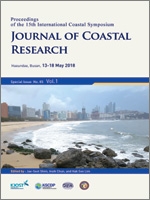Yao, Y.; Huang, Z., and Lo, E.Y.M., 2018. Experimental Study on Floating Debris Generated by Solitary Waves Running up a Composite Beach. In: Shim, J.-S.; Chun, I., and Lim, H.S. (eds.), Proceedings from the International Coastal Symposium (ICS) 2018 (Busan, Republic of Korea). Journal of Coastal Research, Special Issue No. 85, pp. 851–860. Coconut Creek (Florida), ISSN 0749-0208.
Tsunami induced debris-laden flow is a destructive process, since the high speed and energetic tsunami waves could destroy and carry any items they could move. A key limitation in understanding such flows is the lack of quantitative experimental data. A laboratory-based study on a debris-laden flow under tsunami waves, modelled as solitary waves in a 2-D wave flume is reported here with the waves being incident on a composite 3-slope setup. Here, two rows of debris with different separation distances were tested. The debris reduced the maximum inundation with the reduction increased with the additional row of debris. The maximum inundation, maximum and final debris positions were shown to be more sensitive to the incident wave conditions. Ensemble measures and normalized kernel density functions were used to characterize the spread in the maximum and final debris positions. A newly defined dimensionless mass loading is further developed to characterize the inundation reduction. The obtained experimental results should find use in calibration or validation of numerical models and aid in field estimations of tsunami wave conditions via post-event surveys of the inundation and debris extent.





